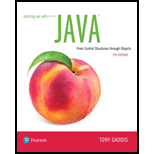
This type of method does not return a value.
- a. null
- b. void
- c. empty
- d. anonymous
The method which does not return a value is called as “void()”.
Hence, the correct answer is option “B”.
Explanation of Solution
Methods:
A collection of statements which together perform an operation is called as methods.
- The main advantage of using method is reusability of code and it reduces the size of the program, because a method can be called for multiple times in the program.
void() method:
The method void executes a set of statements with no return value.
Explanation for incorrect options:
a. null:
The keyword null is used to declare the null data type
Hence, the option “A” is wrong.
c. Empty:
Empty is used to represent a string which has blank value in it.
Hence, the option “C” is wrong.
d. Anonymous:
There is no method called as “anonymous” in Java, but the nameless object in java is termed as anonymous object.
Hence, the option “D” is wrong.
Want to see more full solutions like this?
Chapter 5 Solutions
Starting Out with Java: From Control Structures through Objects (7th Edition) (What's New in Computer Science)
Additional Engineering Textbook Solutions
Modern Database Management
Web Development and Design Foundations with HTML5 (8th Edition)
Introduction To Programming Using Visual Basic (11th Edition)
Starting Out with Java: From Control Structures through Data Structures (4th Edition) (What's New in Computer Science)
SURVEY OF OPERATING SYSTEMS
Starting Out With Visual Basic (8th Edition)
- Programming Logic & Design ComprehensiveComputer ScienceISBN:9781337669405Author:FARRELLPublisher:Cengage
 Microsoft Visual C#Computer ScienceISBN:9781337102100Author:Joyce, Farrell.Publisher:Cengage Learning,
Microsoft Visual C#Computer ScienceISBN:9781337102100Author:Joyce, Farrell.Publisher:Cengage Learning, EBK JAVA PROGRAMMINGComputer ScienceISBN:9781337671385Author:FARRELLPublisher:CENGAGE LEARNING - CONSIGNMENT
EBK JAVA PROGRAMMINGComputer ScienceISBN:9781337671385Author:FARRELLPublisher:CENGAGE LEARNING - CONSIGNMENT  C++ Programming: From Problem Analysis to Program...Computer ScienceISBN:9781337102087Author:D. S. MalikPublisher:Cengage Learning
C++ Programming: From Problem Analysis to Program...Computer ScienceISBN:9781337102087Author:D. S. MalikPublisher:Cengage Learning EBK JAVA PROGRAMMINGComputer ScienceISBN:9781305480537Author:FARRELLPublisher:CENGAGE LEARNING - CONSIGNMENT
EBK JAVA PROGRAMMINGComputer ScienceISBN:9781305480537Author:FARRELLPublisher:CENGAGE LEARNING - CONSIGNMENT Programming with Microsoft Visual Basic 2017Computer ScienceISBN:9781337102124Author:Diane ZakPublisher:Cengage Learning
Programming with Microsoft Visual Basic 2017Computer ScienceISBN:9781337102124Author:Diane ZakPublisher:Cengage Learning





